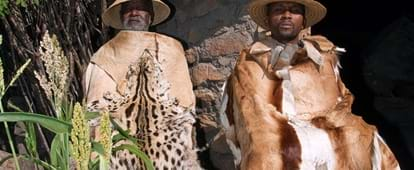By creating an account, I agree to the
Terms of service and Privacy policy
Choose your country and language:
Africa
Americas
Asia Pacific
Europe
TThe Free State culture is a true melting pot of traditions. Free State people have descended directly from several traditional southern African groups, as well as a long line of Dutch forebears. This combination has evolved into the unique South African culture of the Free State today.
Arguably the first group to lay claim to this region were the San (sometimes known as the Bushmen). Their ancient drawings speak of the animals that shared their lives on the Free State plains including, most interestingly, hippos.
There are dozens of examples of San rock art dotted around the province, rated as some of the country's most valued examples.
Further down the timeline, Free State culture is heavily influenced by the Basotho or South Sotho people who arrived here in the late 1700s. Despite many battles through the decades, including with and the European settlers, the Basotho survived and are the dominant Free State cultural group today.

YYou will see hundreds of colourful Basotho huts made of reeds, grass and mud around the province. For a more intimate experience, visit the Basotho cultural village at Qwaqwa and immerse yourself in Sotho traditions. Or visit the Catharina Brand Museum at Ladybrand and see the transition of this culture from past to present.
The arrival in the 1800s of the European settlers, mostly Dutch-speaking farmers from the Cape, and later the British, undeniably had the biggest impact on the region's culture. Various buildings bear testament to these influences, including beautiful sandstone Edwardian and Victorian mansions throughout the province.
The Boers, as the Afrikaans settlers became known, established themselves as a farming force in the area. With this came a rich legacy of traditions including the making of boerekos (farm-style food) and mampoer (a home-brewed alcoholic drink with a serious kick), and traditional folk dancing and music.
Visitors can today enjoy these traditions at towns across the province and partake in warm, farm-style hospitality through the province's choice of ‘farmstay' experiences.
Travel tips & planning info
Who to contact
Free State Tourism
Tel: +27 (0)51 411 4300
Email: info@freestatetourism.org
SANParks
Tel: + 27 (0)12 428 9111
Email: reservations@sanparks.org
How to get here
Fly direct from any of South Africa’s major cities to Bloemfontein Airport. If you’re driving from Johannesburg and Cape Town take the N1 south and north respectively to Bloemfontein. From Durban, take the N3 out of KwaZulu-Natal, and pick up the N5 at Harrismith to Bloemfontein.
Best time to visit
Spring to autumn (September to April). Summer days get very hot, while winter days are mild, with cold evenings. Snow regularly falls on the eastern highlands.
Things to do
The self-drive tourism routes (the Cheetah, Eagle, Lion, Flamingo and Springbok Routes); the National Museum in Bloemfontein; the Basotho Cultural Village; the Golden Gate Highlands National Park (with San art sites); the Catharina Brand Museum at Ladybrand.
NAMPO Farm Show (agricultural show) at Bothaville in May; the Bloemfontein Show (agricultural and entertainment festival) at Bloemfontein in late April/early May (since 1883); the Craft Beer Festival in Clarens in February; the Macufe Mangaung African Cultural Festival in Bloemfontein in October; cultural arts and crafts at the Basotho cultural village; homemade farm crafts at villages around the province.
What to pack
Don’t forget a hat and plenty to sunscreen, even in the winter. Pack warm clothes for winter months as it gets very cold, especially when it snows.
What to eat
Traditional boerekos (farmers’ food) and potjiekos (pot stew) in most towns and villages; authentic African cuisine at the many African cultural villages; the Free State’s famed corn on the cob and juicy cherries.
Related links

